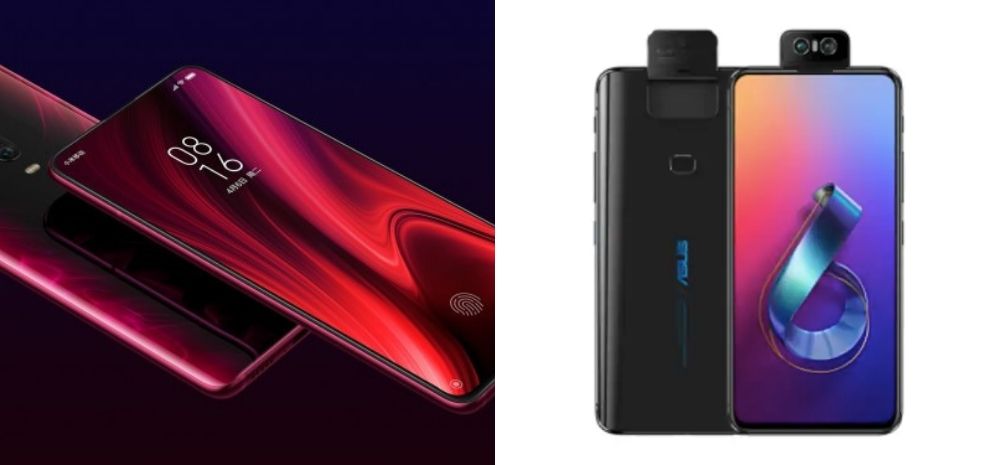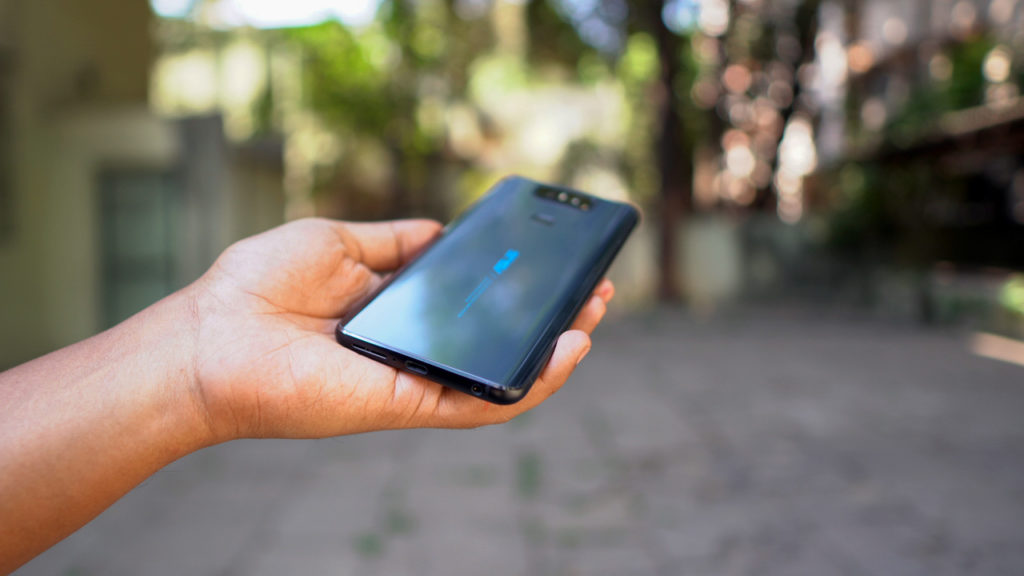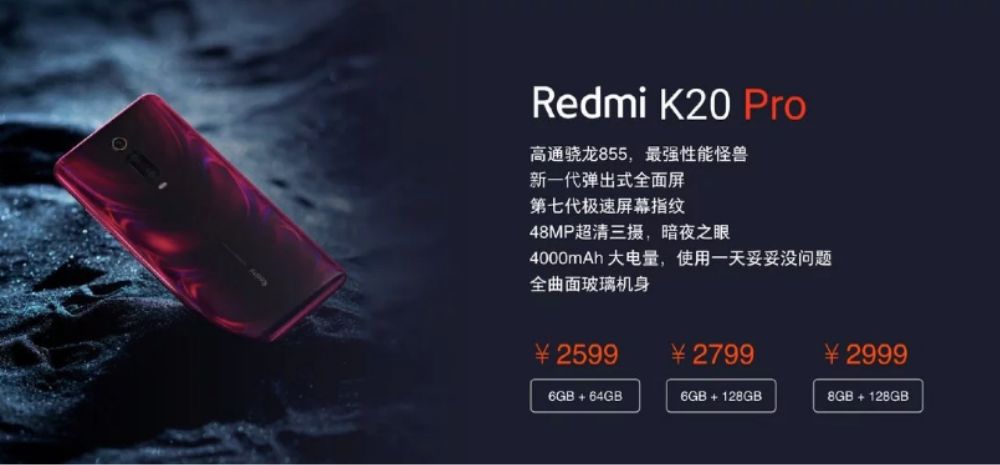Redmi K20 Pro vs Asus 6Z: Finding The Best Entry-Premium Flagship!
Asus unveiled its Zenfone 6 a few days back, and now Xiaomi launched its Redmi flagship, Redmi K20 Pro yesterday in China. Interestingly both the smartphones are pitted against the newly launched newsmaker, OnePlus 7 series.
Both Redmi K20 Pro and Zenfone 6 pack in a few unique features.

Xiaomi and Asus will soon be putting up a good fight in the entry-premium space at around the sub-30,000 segment.
While the OnePlus 7 and the much-costlier Pro model continues to stand tall holding its ground, today we will compare the other two much-talked-about flagships: Redmi K20 Pro and Asus Zenfone 6 Pro.
Let’s compare the two to find out who wins the game at under Rs 30,000.
Contents [hide]
Design & Build Quality: Too Heavy?
Asus Zenfone 6 has a solid and compact build on the out. It’s neither very big, nor heavy in spite of that massive battery. It dons a glass built on both sides, Corning Gorilla 6 upfront and Corning Gorilla 3 at the back. The company is using a rotating module to be used both as front and back cameras.
It’s indeed a unique approach where all companies are going for pop-up sensors and sliders to go notch-less.
In comparison, the Redmi K20 Pro features a body mixed up of glass and metal. With a 3D gradient at the back, the smartphone dons a compact design with curved sides at back. The smartphone weighs 191 grams.
The noticing feature on Zenfone 6 remains the rear-mounted physical fingerprint sensor. Asus decided to go with a sensor at the back below the camera module. Redmi K20 Pro, on the other hand, comes with a seventh generation in-display optical fingerprint scanner.

In many ways, the physical fingerprint sensor is still the best option. Easy to use and no need to spot.
Thankfully, both the company hasn’t ditched the 3.5mm headphone jack in spite of the smartphones being flagships. Kudos to it.
Asus Zenfone 6 has a special third button above the volume rocker called Smart Key. It can be customised to open anything, like Google Assistant or any specific app or for any function. It’s quite handy at times.
Also, Zenfone 6 comes with a Dolby Atmos powered dual speakers.
Notchless Displays: Who’s Got Better?
Starting with the design, Zenfone 6 features a notch-less edge to edge display with a slightly larger chin down under and almost no-bezels on top and sides. Redmi K20 Pro has a similar display design.
Zenfone 6 and Redmi K20 Pro both have a more or less similar screen to body ratio, at more than 91 per cent.
Asus Zenfone 6 packs in a 6.46-inch Full HD+ NanoEdge LCD notchless display. Whereas, Redmi K20 Pro sports a 6.39-inch Full HD+ AMOLED display without any notch in a 19.5:9 aspect ratio.

The AMOLED panel helps it offer 600 nits of maximum brightness with support for HDR content.
Similarly, Zenfone 6 also supports 600 nits of brightness and HDR10. But again, an AMOLED panel is superior to an LCD display.
Also, the Redmi K20 Pro display comes with an in-display optical fingerprint scanner embedded beneath.
Hardware & Storage: Same Same?
Asus ZenFone 6 and Redmi K20 Pro both are powered by the best Qualcomm processor in the market, the octa-core Qualcomm Snapdragon 855. The chip pairs with up to 8GB of RAM and the well-improved Adreno 640 GPU to take control of the graphics.
Thanks to Snapdragon 855, the device can run anything you throw at it.
In terms of daily performance and efficiency, you can rely on both without a second thought. Both can run all the apps without reloading with optimal RAM management.
Redmi K20 Pro can be doubled as a gaming smartphone. It comes with an 8 layer liquid cooling system to keep the phone cool during extended gaming sessions coupled with a three dimension double-sided graphite architecture cooling structure.

Redmi K20 Pro has a special Game Turbo 2.0 feature which optimizes the smartphone for gaming, headphone/sound quality while gaming, optimization for WiFi/ mobile network while gaming and special improvements to touch mode while gaming.
The smartphones will also optimize the dark areas of the screen while gaming to offer a better viewing experience during gameplay.
Software: MIUI / Almost Stock Android?
Asus ZenFone 6 runs on Android 9 Pie with the ZenUI 6 on top. The newly refreshed ZenUI offers a sleek and clean Android UI, offering an almost stock Android experience.
The company has promised that the device will get version upgrade to Android Q and Android R.
Redmi K20 Pro runs on Android 9 Pie-based MIUI 10. But, you also get instant access to the Android Q beta program with K20 Pro.
In comparison to MIUI, Asus has done a great job with the new ZenUI 6 to offer an almost stock-looking Android interface with a number of customisations.
The smartphone also supports a system-wide dark mode. The company has successfully reduced bloatware to just 11 pre-installed apps, and it does run smooth.
Cameras: Three Better Than Two?
Asus Zenfone 6 comes with its own kind of flipping camera. It’s a dual camera system which sits at the back to be used as a rear camera, but rotates to pop out and work as a selfie shooter. It’s a unique concept, something like we previously saw on Samsung Galaxy A80.
The rotates vertically to face the user of the phone. The ZenFone 6 camera can also be used at different angles by controlling the amount of rotation.

The flip is almost instantaneous. It hardly takes a fraction of second to flip in and out.
Coming to optics, the camera comprises of a Sony IMX 586 primary sensor, the 48MP lens with an f/1.79 aperture. It’s paired with a 13MP secondary camera with a 125-degree wide angle lens.
In comparison, Redmi K20 Pro features a three camera set up at the back. The rear triple camera setup on K20 Pro features the 48MP Sony IMX586 camera as the primary lens with an f/1.75 aperture coupled with an 8MP telephoto secondary sensor with an f/2.4 aperture and a tertiary 13MP wide-angle sensor with an f/2.5 aperture and a 124.8-degree field of view.
Redmi K20 Pro comes with a 20MP sensor supporting wide-angle shots where the pop-up sensor can rise and retract smoothly at under 0.8 seconds.
Both Redmi K20 Pro and Zenfone 6 does a fair job offering a great dynamic range with almost accurate colours irrespective of lighting conditions. Both support Google Camera and has a dedicated Night Mode for long-exposed shots.
Battery: Big Vs Huge
Unlike most flagships, Asus Zenfone 6 packs in a humongous 5,000 mAh battery. The huge battery can easily run for close to two days on a single charge. The company is also offering Qualcomm’s Quick Charge 4.0 technology, so that you can juice up really quick.
Inside the box, there’s an 18W wired charger. It can charge up the device enough under 40 minutes to run for a day.
Redmi K20 Pro, in comparison, houses a smaller yet huge 4,000 battery. The smartphone supports AI smart optimization to extend the phone’s battery to last longer.
Unlike Zenfone 6, Redmi K20 Pro comes with 27W wired fast charging capabilities compared to Zenfone 6’s 18W fast charging technology.
Finally, Pricing: Cheaper The Better?
Asus ZenFone 6 has been launched globally in three storage confirmations. The base models costs EUR 499 (around Rs 39,150) with 6GB RAM and 64GB storage. The mid-end model with 6GB RAM and 128GB storage costs EUR 559 (around Rs 43,850).
Finally, the top-tier 8GB RAM with 256GB storage model is priced at EUR 599 (around Rs 47,000).
Asus Zenfone 6 will be available in two colour combinations: Midnight Black and Twilight Silver.
Asus Zenfone 6 should cost at around 30,000 rupees in India to match up with the competition.

Redmi K20 Pro is also available in four variants. It has been launched in China starting at 2,499 yuan (around Rs 25,250) for the base model with 6GB RAM and 64GB storage. The mid-version model with 6GB RAM and 128GB storage costs 2,599 yuan (around Rs 26,250).
Finally, the top-end models featuring 8GB RAM with 128GB storage and 8GB RAM with 256GB storage is priced at 2,799 yuan (around Rs 28,250) and 2,999 yuan (around 30,250) respectively.
In India, Redmi K20 Pro is expected to start at around 25,000 rupees.
Redmi K20 Pro will be available in three colour options – Carbon Black, Glacier Blue and Flame Red.
Both Asus India and Xiaomi India have confirmed the launch of their respective flagships in India. While the official dates are yet to be announced, the India launch of both Zenfone 6 and K20 Pro should happen sometime in June.

Comments are closed, but trackbacks and pingbacks are open.